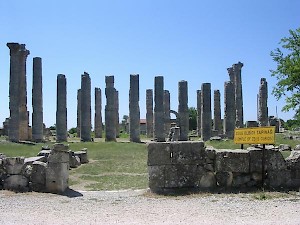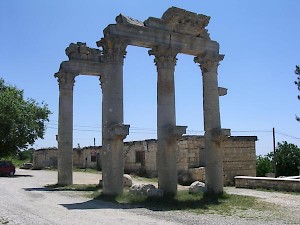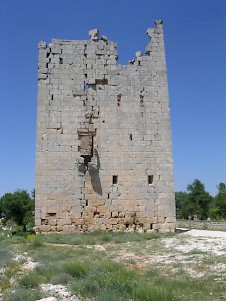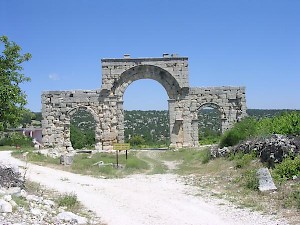Olba-Diocaesarea
Q65044503Olba (Ὤλβα): Seleucid city in Rough Cilicia, southern Turkey; its Roman name was Diocaesarea (Διοκαισάρεια), and its modern name is Uzuncaburç

In Antiquity, Diocaesarea, or Olba, was well-known for its temple of Zeus, which was rebuilt in c.300 BCE by Seleucus I Nicator, the founder of the Seleucid Empire. At that moment, Olba was already an ancient town. It had been the capital of a small, independent state named Pirindu, which had been annexed by the Achaemenid Empire. Why Seleucus decided to rebuilt this sanctuary, has not been not recorded.
Hellenistic town

It appears that Seleucus also (re)founded the town itself, because it is of a design that was also used in several other Seleucid cities. This design consisted of a straight and wide main street (usually called "Colonnaded Street"); the course of the walls was determined by the shape of the site; and there was a citadel on a hill top - although in Diocaesarea it was not very pronounced. The same arrangements can be found in Syrian cities like Apamea, Chalcis, Cyrrhus, Dura Europos, and Damascus.
The Colonnaded Street was about 250 meters long. The remains of an ancient arch at the beginning of this street are still there. It has interesting consoles on its pillars, which once carried statues.
According to a legend told by the Greek geographer Strabo,note the original temple of Zeus Olbius had been founded by Ajax, one of the Greek heroes of the Trojan War. The priests belonged to the Teucrid dynasty: every man of this family was called either Ajax or Teucer. Ruled by these priests, Olba remained a small theocracy during the Seleucid age.

Several monuments date back to this period. One of these is the big tower, which was built in the second half of the third century BCE. The inhabitants were very proud of this building, putting a picture of it on their coins. It is still the most remarkable monument in the neighborhood and the modern town, Uzuncaburç, was named after it ("tall tower"). It is at the highest point of the city, which may have been the citadel.
Roman town
When the Romans appeared on the stage after their war against the Cilician pirates (67 BCE), they accepted the town's autonomy. The name "Diocaesarea" was adopted during the reign of the emperor Vespasian (r.69-79). During his reign or the reign of his son Domitian (i.e., between 69 and 96), a temple of Tyche was given as a present to the city by a man and a woman named Oppius and Kyria, his wife. The cult may be older, though, because the Colonnaded Street leads up to it, suggesting that the road was oriented on the sanctuary.
Among the other monuments that you can still see, is the nymphaeum (monumental fountain), which was once decorated with statues that are now missing. The aqueduct, which is about twenty kilometers long, is still functioning and serves a number of villages in the neighborhood. The Roman theater was, according to an inscription, built during the reign of the emperors Marcus Aurelius and Lucius Verus, i.e. between 161 and 169. Some 2500 people could find a seat.
 Diocaesarea, Roman temple of Tyche |
 Diocaesarea, Roman theater |
 Diocaesarea, Nymphaeum |
 Diocaesarea, Hellenistic mausoleum |
Byzantine town

One of the youngest monuments is the northwestern city gate. An inscription states that it was erected during the reign of the emperor Arcadius (r.395-408). It is about 32 meters wide and 12 meters high; the width of the wall is just over one meter. Still, it may have served as a real fortification, because this was the age of the Isaurians, inhabitants of the mountains of Cilicia, who were a permanent threat to the Roman interests in this part of Anatolia.
In this age, the temple of Zeus was converted into church, which explains why it is still quite well-preserved.







